Report
The 2025 social media report
Consumer insights behind the trends

People often assume that the new will replace the old. On social media, stories offered an alternative to posts, niche apps were expected to grab more seats at the table, video came to replace text, and AI influencers have started pushing out content faster than real ones.
It’s incredibly easy for businesses to jump the gun.
But consumer attitudes and behaviors move slower than the technologies driving them, and can even start back-pedaling. As we’re going to see, old habits really do die hard.
We don’t have a crystal ball - no one does. Instead, we’re serving up the top changes that have taken place over the last year, and suggesting ways for brands to prepare for what’s next.
Key insights
Consumers scroll to connect, discover, and stay informed
Social platforms are evolving, as are the reasons we scroll. News consumption, messaging friends and family, and product research are up on certain sites. Brands need to lean into trending conversations and cater to the ways their audience seeks information.
People want both free speech and online safety
Trending videos are about more than likes
Some apps don't get enough attention from marketers
With consumer insight, the future’s full of possibility

Back every move with GWI Spark
Why wait for insights when you can get them in seconds? GWI Spark gives you the answers you need to ignite your next big idea, so you can make smart decisions, maximize ROI, and stay ahead of the competition.
Try GWI Spark01
Our social status:
It’s complicated

People say they’ll scroll less, but the data tells us otherwise. In 2024, only a quarter of those who made a New Year’s resolution to spend less time on social media actually achieved a good amount of their goals or more. And let’s be real - it’s tricky to opt out when these apps are pretty much woven into school, work, and social life.
Many of us accept that the genie’s out of the bottle, and since there’s no turning back, it’s time to shift the conversation. The real opportunity is in focusing on what we can control, and brainstorming ways to make the hours we spend in this space worthwhile.
What you click is what you get
- Source: GWI Core Q4 2024
- Base: 95,514 internet users aged 16-34
Already a GWI user? Explore the data on the GWI platform
- What are your main reasons for using social media?
- Which of the following do you feel describes you? (I think social media is good for society)
- How long would you say you did each activity for the last/most recent day you did it? If you did the activity in multiple sessions within the day, think of the total time spent. (Browsed social media (e.g. posts, stories, ads), Watched short videos (e.g. Reels, TikToks), Watched videos (e.g. how-to’s, vlogs))
- Source: GWI Core Q4 2024
- Base: 95,514 internet users aged 16-34
Already a GWI user? Explore the data on the GWI platform
- What are your main reasons for using social media?
- Which of the following do you feel describes you? (I think social media is good for society)
- How long would you say you did each activity for the last/most recent day you did it? If you did the activity in multiple sessions within the day, think of the total time spent. (Browsed social media (e.g. posts, stories, ads), Watched short videos (e.g. Reels, TikToks), Watched videos (e.g. how-to’s, vlogs))

Companies can help turn lurkers into engaged users and link that positive experience to their brand by driving participation; we’ll dig into this more later on.
02
Where we scroll,
and why

Top platforms by generation
Ranked order based on the % in each generation who say they use the following apps at least daily
- Source: GWI Core Q4 2024
- Base: 216,228 internet users, outside China, aged 16-64 (16+ in select markets)
Already a GWI user? Explore the data on the GWI platform
- Source: GWI Core Q4 2024
- Base: 216,228 internet users, outside China, aged 16-64 (16+ in select markets)
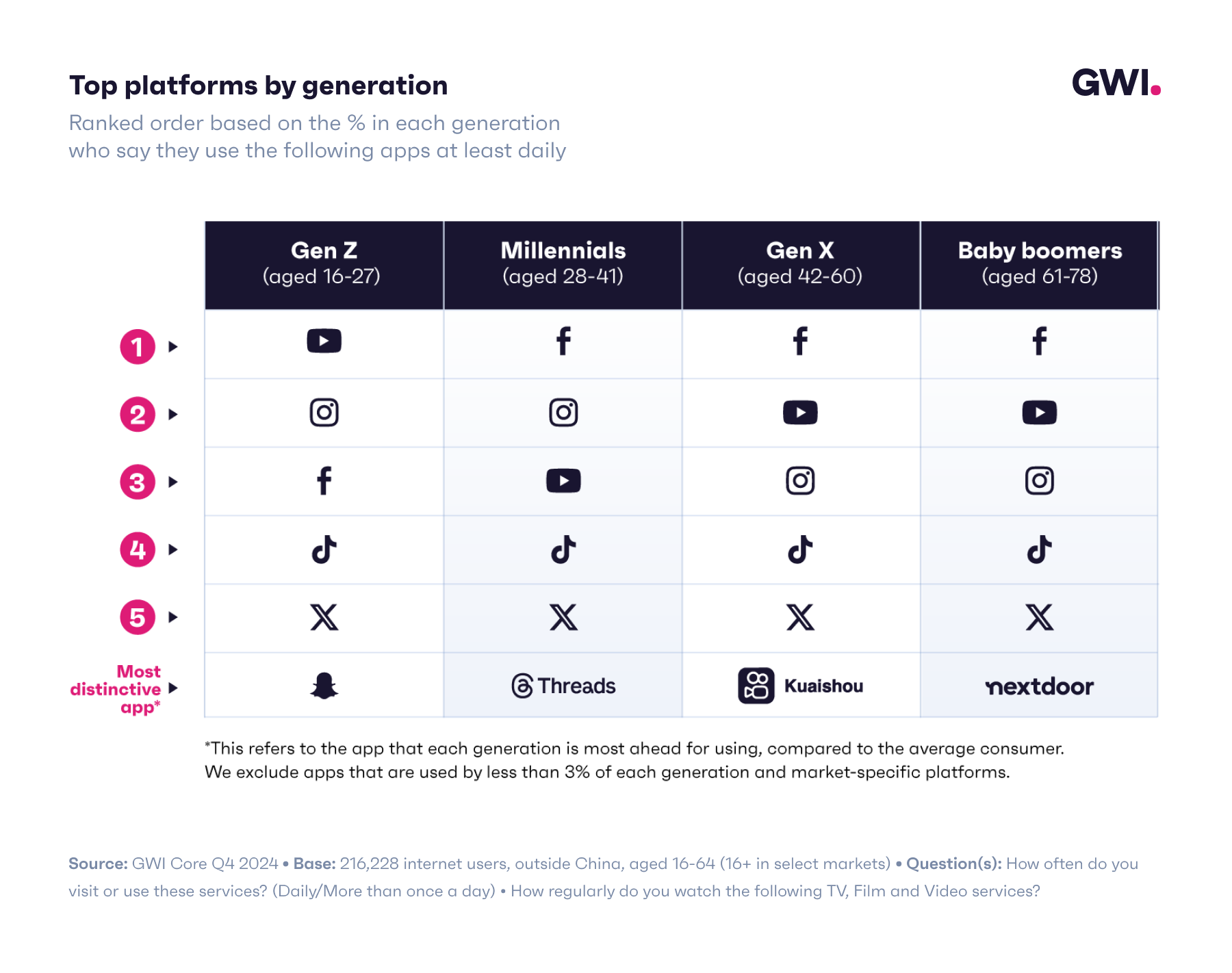
One of the biggest surprises? Millennials have embraced Threads much more than average, partly because they’ve grown up on Meta’s apps and find them easy to use. And their Threads engagement is helping to make it a household name.

Meet your AI assistant, GWI Spark
Fast insights. Big impact. Zero guesswork. GWI Spark is changing the game for researchers, marketers, and brands everywhere by giving you real audience insights from 50+ markets in just a click.
Try GWI Spark freeSocial media's latest plot twist: Threads
When Threads launched in summer 2023, many wondered if the hype would last. Was the instant success just an Instagram-fueled rush or could it actually lock in regular users?
Fast forward to today, and it’s now the fastest-growing social platform across all generations. To put this into context: the share of people logging onto it each day matches the share who work in the IT sector. So, it’s definitely one to watch.
A common thread
Year-on-year percentage growth in daily usage of the following platforms
- Source: GWI Core Q4 2023 & Q4 2024
- Base: 215,092 (Q4 2023) and 204,217 (Q4 2024) internet users, outside China, aged 16-64
Already a GWI user? Explore the data on the GWI platform
- Source: GWI Core Q4 2023 & Q4 2024
- Base: 215,092 (Q4 2023) and 204,217 (Q4 2024) internet users, outside China, aged 16-64
Already a GWI user? Explore the data on the GWI platform
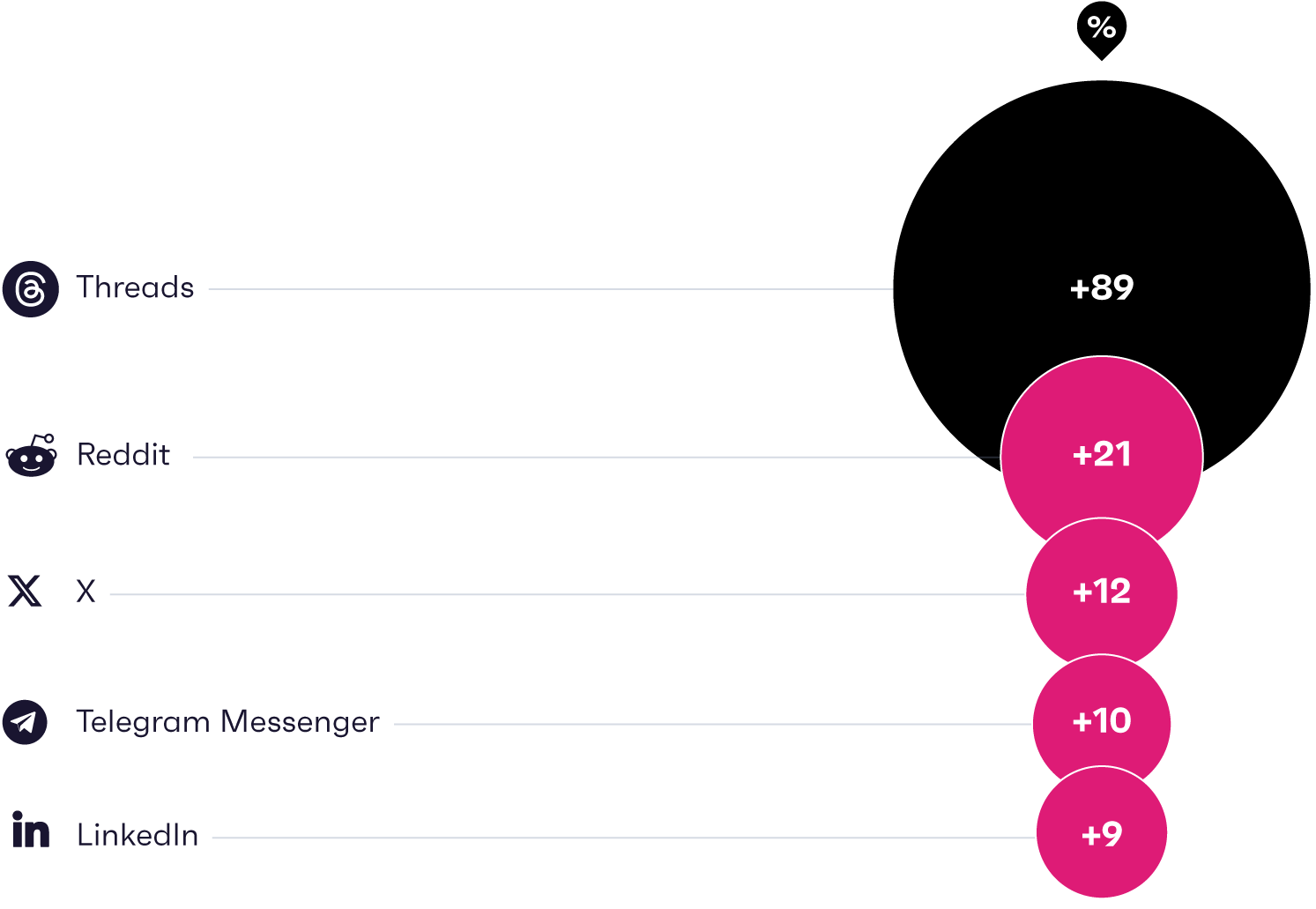
This might have something to do with the fact that 2024 was the year of elections worldwide, putting social media at the heart of political discussions. Consumers wanted a place to share ideas on policies and candidates, driving them to text-based platforms centered around open conversation. And in certain markets, we’ve good reason to believe some of these users will stick around.
Taiwan spotlight

Threading its way through Taiwan
Threads is used more in Taiwan than anywhere else in the world, with 1 in 5 consumers logging on daily. Now it’s the third most-used app in this market.
Threads’ timing really couldn’t have been better, with the 2024 Taiwanese election giving it legs. It was a popular place for young consumers and Democratic Progressive Party (DPP) voters to discuss ideas or policies. It even attracted politicians, with President Lai reportedly getting more interaction on Threads than other major platforms.
Threads isn’t just for discussing ideas either. Many big-name Taiwanese influencers are already on the app, and it’s popular among consumers who use social media to follow them, avoid FOMO, and get brand updates. This means there’s an opportunity for companies to start experimenting with this kind of marketing, if they haven’t already.
Read the room, rewrite the playbook
Maybe more important than understanding what the most used platforms are, or which apps are trending, is understanding why scrollers scroll in the first place.
The social media remix
% growth since Q4 2021 in the number of each platform's users who say they log onto it for these reasons
- Source: GWI Core Q4 2021 & Q4 2024
- Base: 314,821 users of 3 social media apps, outside China, aged 16-64
Already a GWI user? Explore the data on the GWI platform
- Source: GWI Core Q4 2021 & Q4 2024
- Base: 314,821 users of 3 social media apps, outside China, aged 16-64
Already a GWI user? Explore the data on the GWI platform
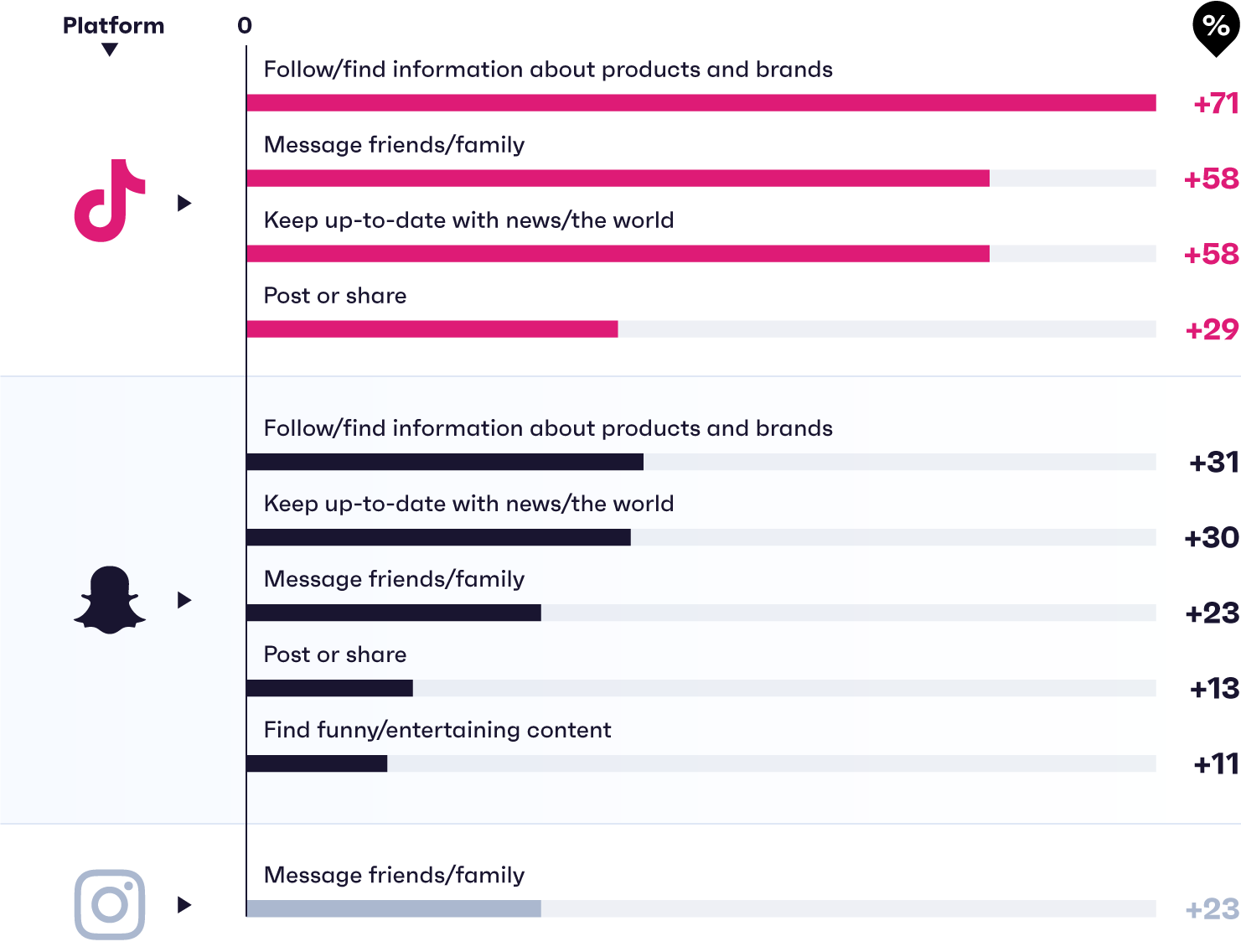
A growing reason for using social media is consuming news. Not only is this a top use case for various text-based platforms, but more people are turning to video-based apps or features to get their news fix. In fact, some major news outlets now rely on Reels more than carousels on Instagram.
There are other big shifts happening on these apps too. For starters, a bigger share of users are logging on to message friends, and to share or post content. This is lighting up DMs and group chats around the world, and driving social media sites to invest in those spaces. Brands can ride this wave by prioritizing content that taps into inside jokes and common experiences among their target audience. Humor lands best when it's personalized.
And most importantly for brands, more scrollers are doing product research on certain sites. Understanding how content’s discovered on each platform should be an important part of any social strategy. It’s not just about reach either, it’s about getting in the middle of relevant or trending conversations. Hilton, for example, finds people discussing imminent travel issues and jumps right in.
Ask our customers
Right now, we’re seeing a big difference in performance based on ad placement, and it’s tied into the behaviour consumers show on each platform, and what they’re expecting from their experience. We see a much higher volume of leads come through from ads in feed, but Stories and Reels get great watch completion rates and we see a higher conversion rate despite lower volumes. This difference comes from consumers' expectation to move out of the app when they’re scrolling on their feed, but those watching videos are much more dialed into that activity. They’re only going to click through if they’re super engaged.
03
Checking (not curating) the convo

Debates around free speech are everywhere, and they're linked to several key trends.
There’s been an ongoing rise in Americans distrusting the media, with half of Republican voters wishing news outlets were less biased. Many people think contentious, yet valid, perspectives are being unfairly filtered out. And podcasts' ability to offer uncensored, unedited information has been put forward as a reason for them having a surprisingly big impact on 2024’s US election.
Telegram Messenger might be growing for a similar reason: it presents itself as a censorship-free space.
All the signs seem to point one way: free speech matters to consumers. And if you ask them, most will agree.

We should take that with a pinch of salt though. People generally believe there’s a difference between hate speech and free speech, with more caring about user safety than the latter. Around half also agree that social media sites should be able to control the content users see, which is a seemingly contradictory outlook experts call “the moderation paradox.” Basically, consumers don’t want companies to censor them too much, or troublemakers to put us in harm’s way either.
This is partly why people have turned to BlueSky; having a safe space to post in, liking its approach to content moderation, and no viewing restrictions are popular reasons for signing up. Users can essentially create or join nodes, each with its own unique moderation policy and rules, which caters to the demand for both user safety and free speech.
The Reddit-ification of social media
Not only is there interest in the community-driven model, but several platforms have replaced fact-checkers with community notes. Once enough people believe a note is helpful, it’s then shown to others. This seems to be the way social media’s headed, which could influence our behavior and expectations.
In the past, we’ve been told: “Don’t say anything online that you wouldn’t want plastered on a billboard with your face on it.” People know the internet’s written in ink and many are wary about expressing their opinions, in case it gets misread, scrutinized, or puts them at risk of being “canceled.” Even 12-15 year olds are mindful of this; just 39% feel they can say what they really think on social media, which is partly why there’s so much passive consumption.
Still, change may be on the horizon. In a fact-checker-free zone, it’s possible more will feel it’s their responsibility to rate content and start behaving like Redditors, especially with TikTok introducing a dislike button that echoes Reddit’s up-vote/down-vote system. And brands have an opportunity to drive conversation even more and help turn some observers into commenters.
To start with, it’s worth knowing what online self-expression means to consumers.
What self-expression means to sharers
% who say discussing opinions is a top reason for using social media and that online "self-expression" means...
- Source: GWI Zeitgeist January 2025
- Base: 2,170 internet users who say they mainly use social media for sharing/discussing opinions in 11 markets aged 16-64 (16+ in select markets)
Already a GWI user? Explore the data on the GWI platform
- Source: GWI Zeitgeist January 2025
- Base: 2,170 internet users who say they mainly use social media for sharing/discussing opinions in 11 markets aged 16-64 (16+ in select markets)
Already a GWI user? Explore the data on the GWI platform
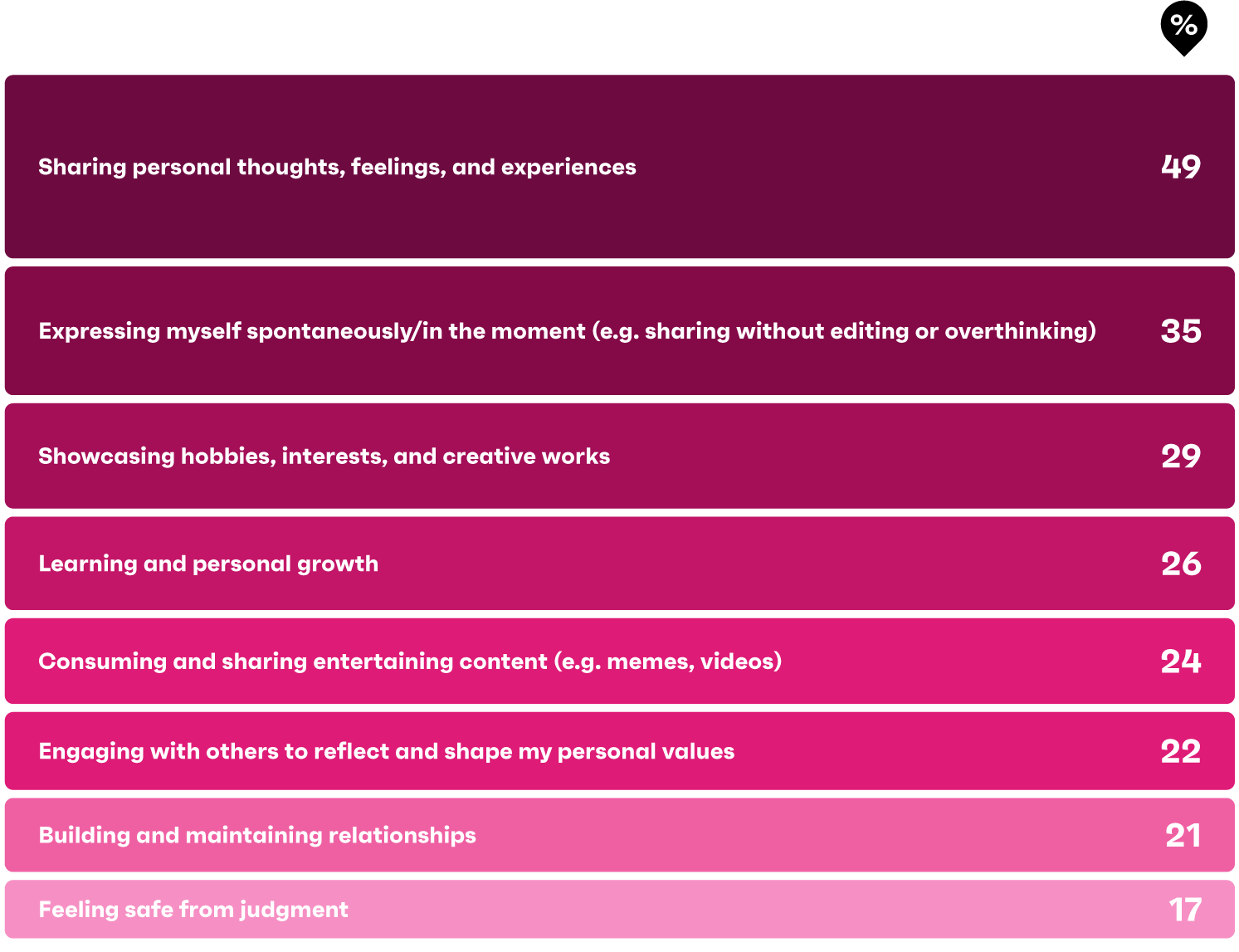
According to those who use social platforms for discussing opinions, it’s not just sharing personal thoughts - it’s about sharing them spontaneously, showcasing interests, and reflecting. And there are a number of platform features that can help here.
Ask our customers
Reddit’s rapid rise in popularity is likely another symptom of content fatigue. Gen Z are gravitating toward spaces where their interests are easier to engage with, where they can have deeper, more meaningful interactions with like-minded people, and where they can genuinely contribute to and be part of a community. Brands that adapt wisely to this shift won’t just redirect their ad spend but will focus on actively and meaningfully engaging with its thriving communities.
Breaking the ice
Private communities on in-app features like Facebook Groups can encourage people to post their feelings, favorite content, and learn. For example, Headspace’s group is a safe space where members can chat about what’s worked on their mindfulness journey, and what hasn't, as well as broader societal issues.As the popularity of BlueSky and the reasons for using it demonstrate, many scrollers want others to challenge their ideas - as long as it’s done in a respectful way. And this speaks to how brands should run their customer communities. It might be beneficial to open up conversations around group guidelines and let users shape them, rather than deleting opinions based on gut instinct.
Anywhere can be a canvas
% of each platform's users who say they've done the following on it in the last month
- Source: GWI Core Q4 2024
- Base: 195,297 users of 6 social media apps, outside China, aged 16-64 (16+ in select markets)
Already a GWI user? Explore the data on the GWI platform
- Source: GWI Core Q4 2024
- Base: 195,297 users of 6 social media apps, outside China, aged 16-64 (16+ in select markets)
Already a GWI user? Explore the data on the GWI platform
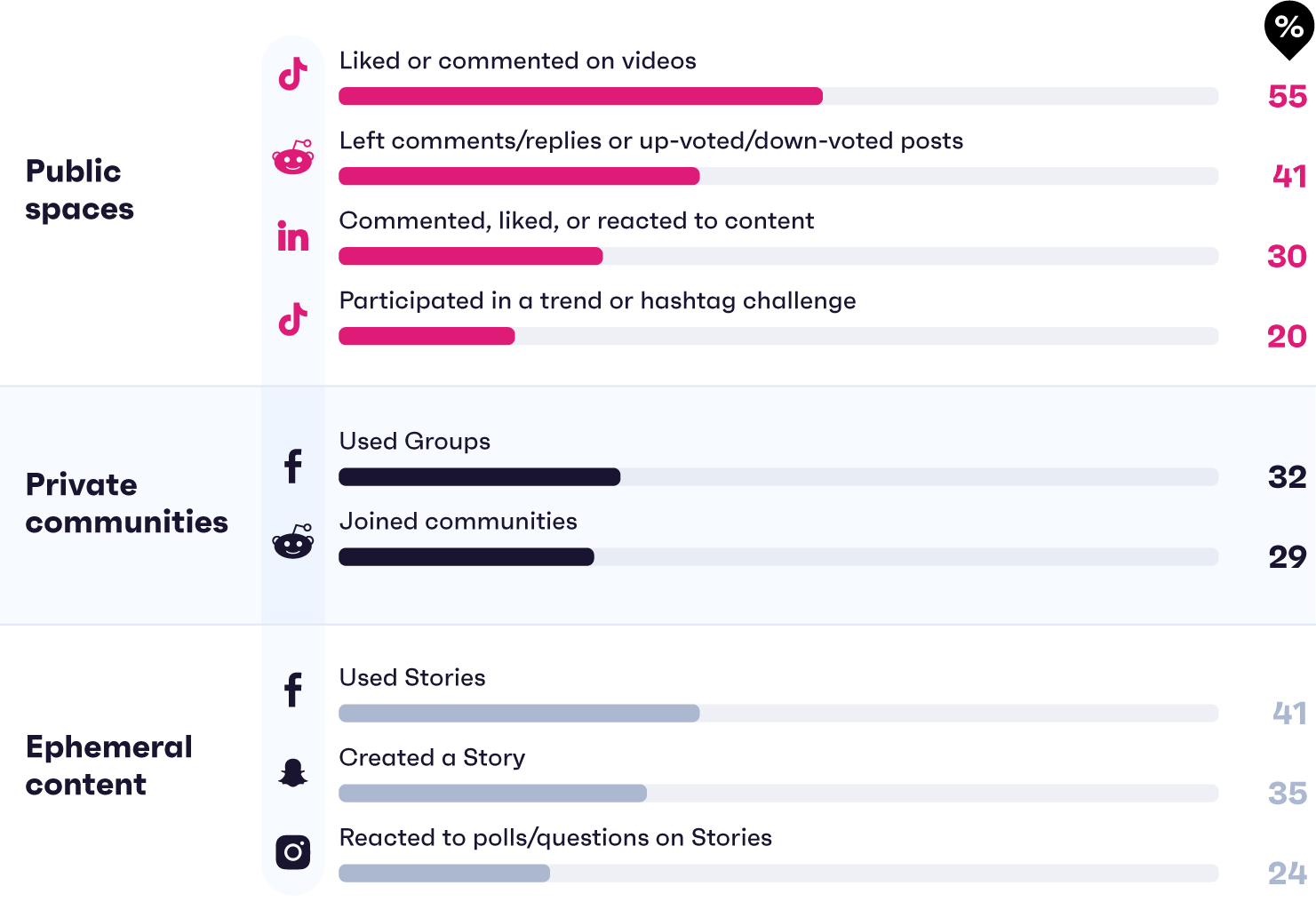
Last but not least, disappearing content can empower people to express themselves in the moment. Setting up polls or questions on Stories is a great way to do product testing and get audiences’ honest first reactions.
04
Lights, camera,
watch
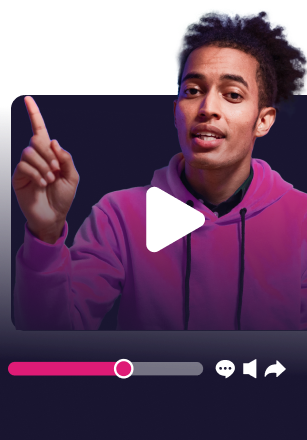
Video: A universal language
% of each platform's users who say they've done the following on it in the last month
- Source: GWI Core Q4 2024
- Base: 84,602 users of 6 social media apps, outside China, aged 16-64 (16+ in select markets)
Already a GWI user? Explore the data on the GWI platform
- What have you done on each app in the last month?
- Source: GWI Core Q4 2024
- Base: 84,602 users of 6 social media apps, outside China, aged 16-64 (16+ in select markets)
Already a GWI user? Explore the data on the GWI platform
-
What have you done on each app in the last month?
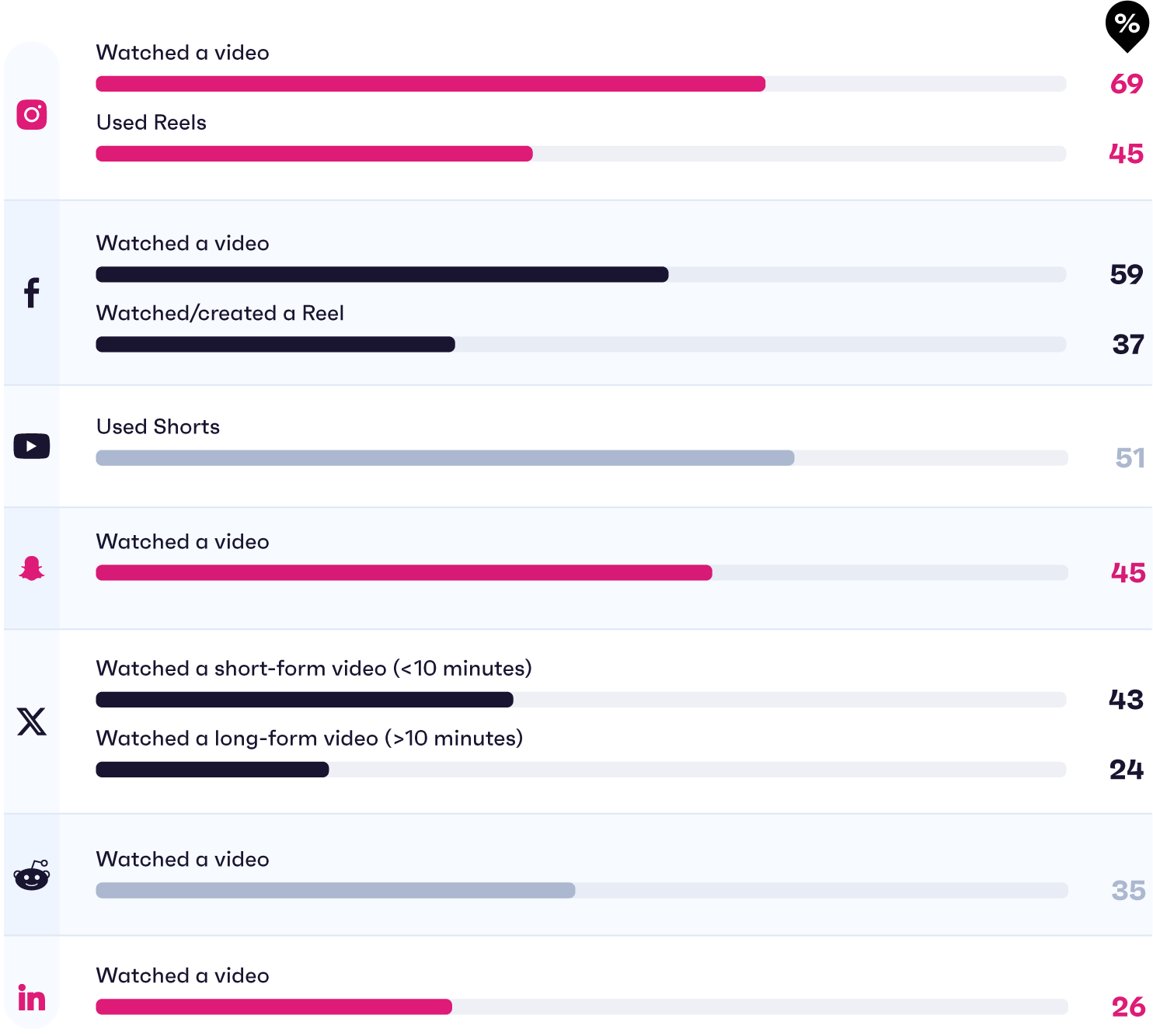
Reels engagement among Instagrammers has grown by 25% since Q4 2021, and the platform has since expanded the max length to 3 minutes for users who want longer content. Video is now such a vital part of the platform’s experience that it’s said to be considering a separate app for this kind of material.
It’s not the only video-centric platform trying to accommodate all types of video either. Over half of YouTubers have used Shorts in the last month, and TikTokers can now record 10 minute videos, or even upload 60 minute videos to the platform.

Make smarter moves with GWI Spark
If you’re not using GWI Spark, you’re already behind. Get access to trustworthy consumer insights to plug into pitches, craft compelling campaigns, and build better products - all powered by AI.
Try GWI SparkThe crown jewel: Video marketing
Video comes with this added bonus: scrollers are generally more receptive to video-based marketing than its text-based equivalents.
Seeing is believing
% who use the following for product research and say they trust what online reviews say about products/services
- Source: GWI Core Q4 2024
- Base: 240,247 internet users aged 16-64 (16+ in select markets)
Already a GWI user? Explore the data on the GWI platform
- Source: GWI Core Q4 2024
- Base: 240,247 internet users aged 16-64 (16+ in select markets)
Already a GWI user? Explore the data on the GWI platform
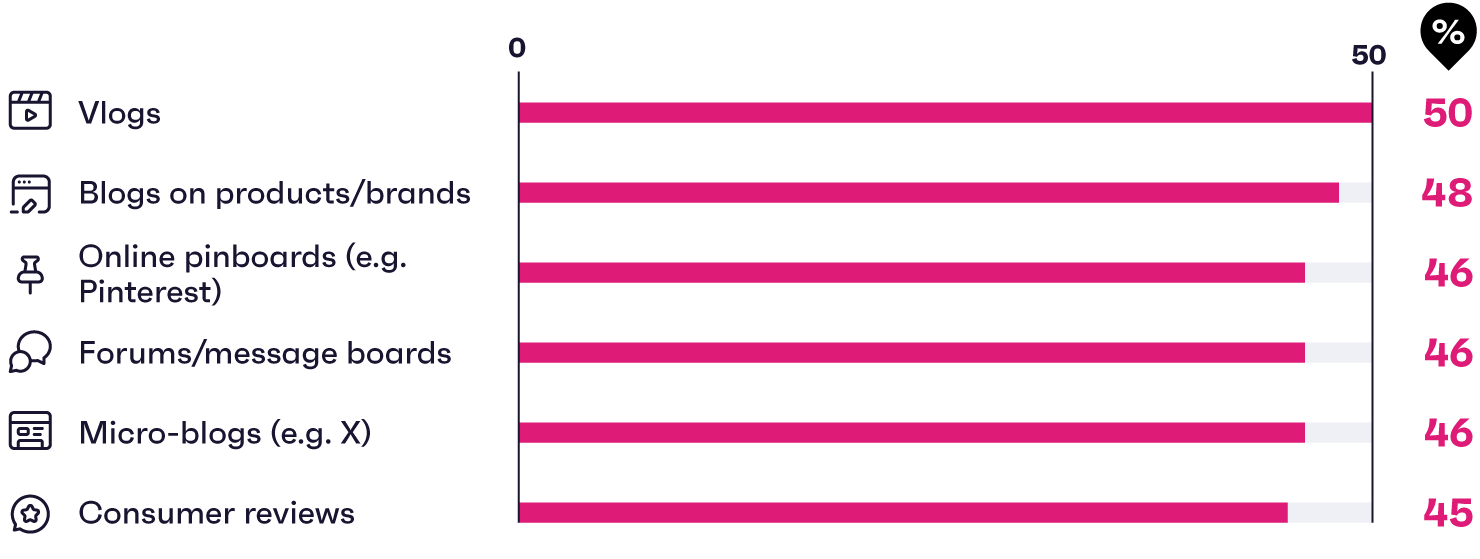
Of all the different media types we track, people who turn to vlogs for product research are the most likely to trust online reviews. Vloggers can walk viewers through the whole experience from unboxing a product to a final review, providing lots of social proof in the process.
Product demos can also help influencers reassure followers in today’s low-trust environment, as many are motivated to buy from influencers because they’ve seen them use a product.
And think about where these video reviews or vlogs are most likely to land. For instance, those who watch videos on Reddit are more likely to follow gaming and fitness experts, so brands in these sectors may want to be more active on the platform. Meanwhile, people who watch videos on Facebook are most distinct for following politicians, royalty, and TV shows or channels, so this might be a better space for broadcasters and their brand ambassadors.
Ask our customers
As consumer behavior continues to evolve, understanding platform-specific viewing habits is crucial for brands. We know social media users consume different channels with different goals in mind. Rather than simply investing in the most popular channels, it's all about being strategic - aligning our content choices with our target audience and campaign goals. The key takeaway is to tailor content not only to platform preferences but also to the unique viewing motivations of each audience to maximize engagement and outcomes.
Up for review? Outdated KPIs
Consumers are using platforms more to find content, message each other, and do product research - and video’s in the driver’s seat. If brands want to nail this, it all starts with a strategy that focuses on the right metrics.

Consumers consistently watch videos made by brands, but there’s been a drop in people following accounts across the board. Instead, consumers trust their feeds to show them relevant topics and “bring them back” to content they like. Welcome to the age of algorithm-based social media.
Brands should start prioritizing other metrics over follower count when they pay to promote their videos. Things like watch time, video completion rates, and the number of actions like shares, saves, and forwards show how engaging content is, and how likely it is that people are talking about what they’ve seen.
Learning how each platform’s algorithm works and differs from others will also be important for brands as they reshuffle video KPIs. Many platforms have promotional offers, and learning the ins and outs of how (and how much) these push their content is vital.
USA spotlight
Livestream nation
TikTok introduced livestreaming to the app in 2020, but it seemed to be a more popular feature globally, and particularly in Eastern markets, than in the US. Livestreaming’s been popular in APAC for a while, with mukbang streams and live shopping capturing viewers’ attention long before TikTok existed.
But in the last few years, it’s picked up on certain apps in the US. Sites like Twitch have made livestreaming features desirable on other apps; and today, nearly 2 in 5 US TikTokers have watched a livestream on the app in the last month, which puts it above the global average.
TikTok livestreams: Americans can't get enough
% of TikTok users in each region who say they've watched a livestream on the app in the last month

Source: GWI Core 2020-2024 (average of all waves) • Base: 1,510,488 global TikTok users, outside of China, and 188,790 US TikTok users aged 16-64 • Question: What have you done on TikTok in the last month?
Influencers are fond of livestreams as they can receive gifts directly from viewers, and top streamers attract thousands of devoted fans. It could be a good option for marketers too, nicely combining two things that are already popular with today’s consumer - creators and community.
When it comes to livestream shopping, Western brands can learn from APAC, where 2 in 3 livestream shoppers prefer normal people hosting events. They can surely build on existing content, and maybe even look further back to the success of QVC, a company that reigned in live shopping on TV.
05
Add social influence
to cart

Influencers are taking up a bigger share of accounts followed
Ranked order based on the % who say they follow these accounts
- Source: GWI Core Q4 2020 & Q4 2024
- Base: 156,747 (Q4 2020) and 204,217 (Q4 2024) internet users, outside of China, aged 16-64
Already a GWI user? Explore the data on the GWI platform
- Source: GWI Core Q4 2020 & Q4 2024
- Base: 156,747 (Q4 2020) and 204,217 (Q4 2024) internet users, outside of China, aged 16-64
Already a GWI user? Explore the data on the GWI platform
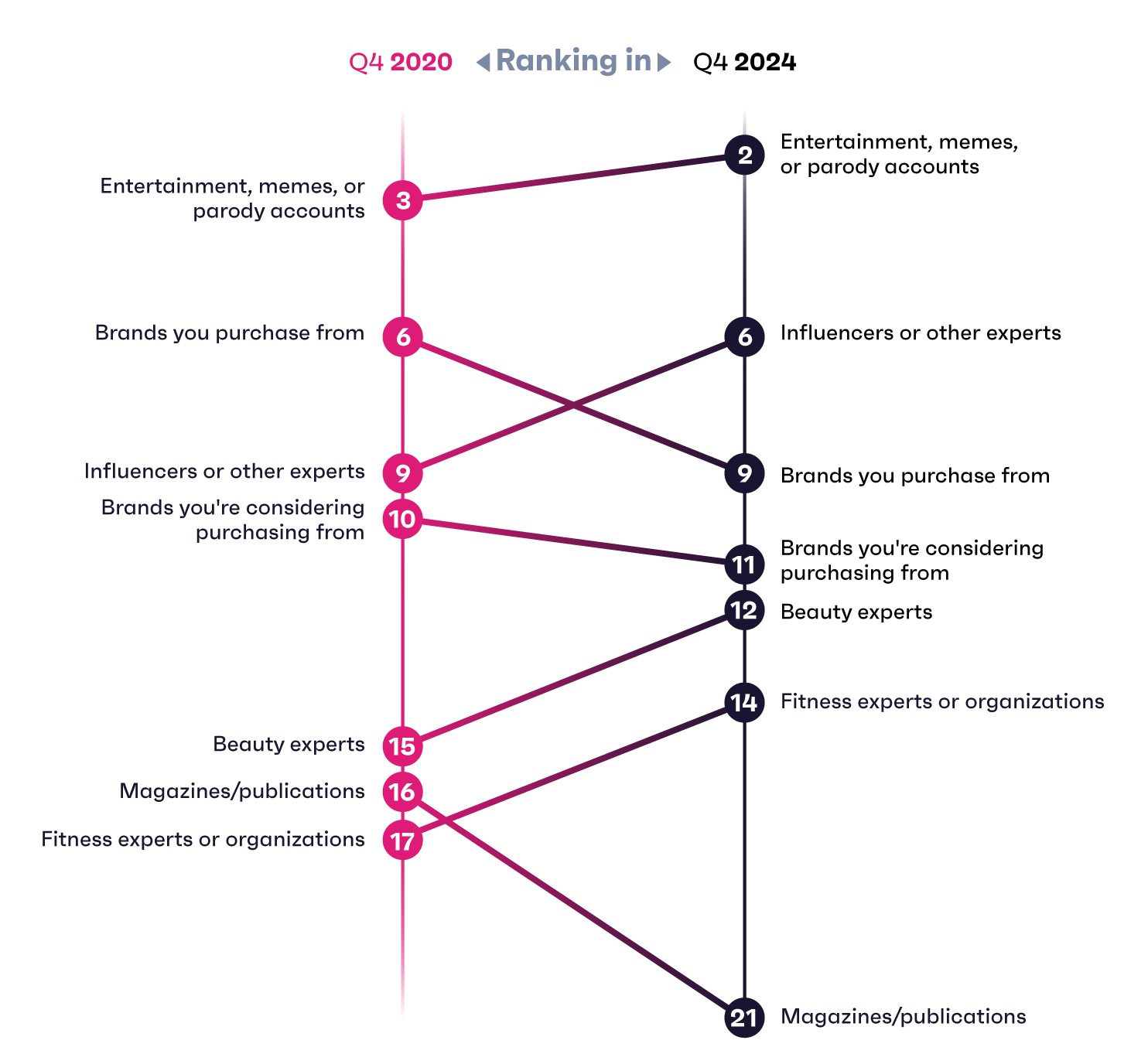
Memes wield a lot of power in our culture, but brands don’t need to join in on every trend. The meme cycle moves fast, and brands can risk being seen as out of touch if they act too slowly or miss the mark. Instead, partnering with meme accounts and creators can put consumers in a good mood before seeing products.
Scroll past the memes on an average social media feed and you might see some influencer content. It’s understandable that brands want to direct consumers to their own account, but picking the right influencers to get them there is essential. It's an even bigger deal for beauty and fitness companies, given these kinds of accounts are taking up more room at the table.
Needs-based marketing is the best marketing
Brands need to pick influencers that have a clear use case for their product, and an audience of potential customers who could realistically make use of it. There are plenty of good examples of collabs, but how can brands know what’ll work for them, and what won't?
Needs-based marketing wins out
% in each group who say the following best explain why they researched or purchased a product/service after seeing it on a social platform
- Source: GWI Zeitgeist September 2024
- Base: 12,260 internet users, and 2,640 influencer followers, in 11 markets aged 16-64 (16+ in select markets)
Already a GWI user? Explore the data on the GWI platform
- Source: GWI Zeitgeist September 2024
- Base: 12,260 internet users, and 2,640 influencer followers, in 11 markets aged 16-64 (16+ in select markets)
Already a GWI user? Explore the data on the GWI platform
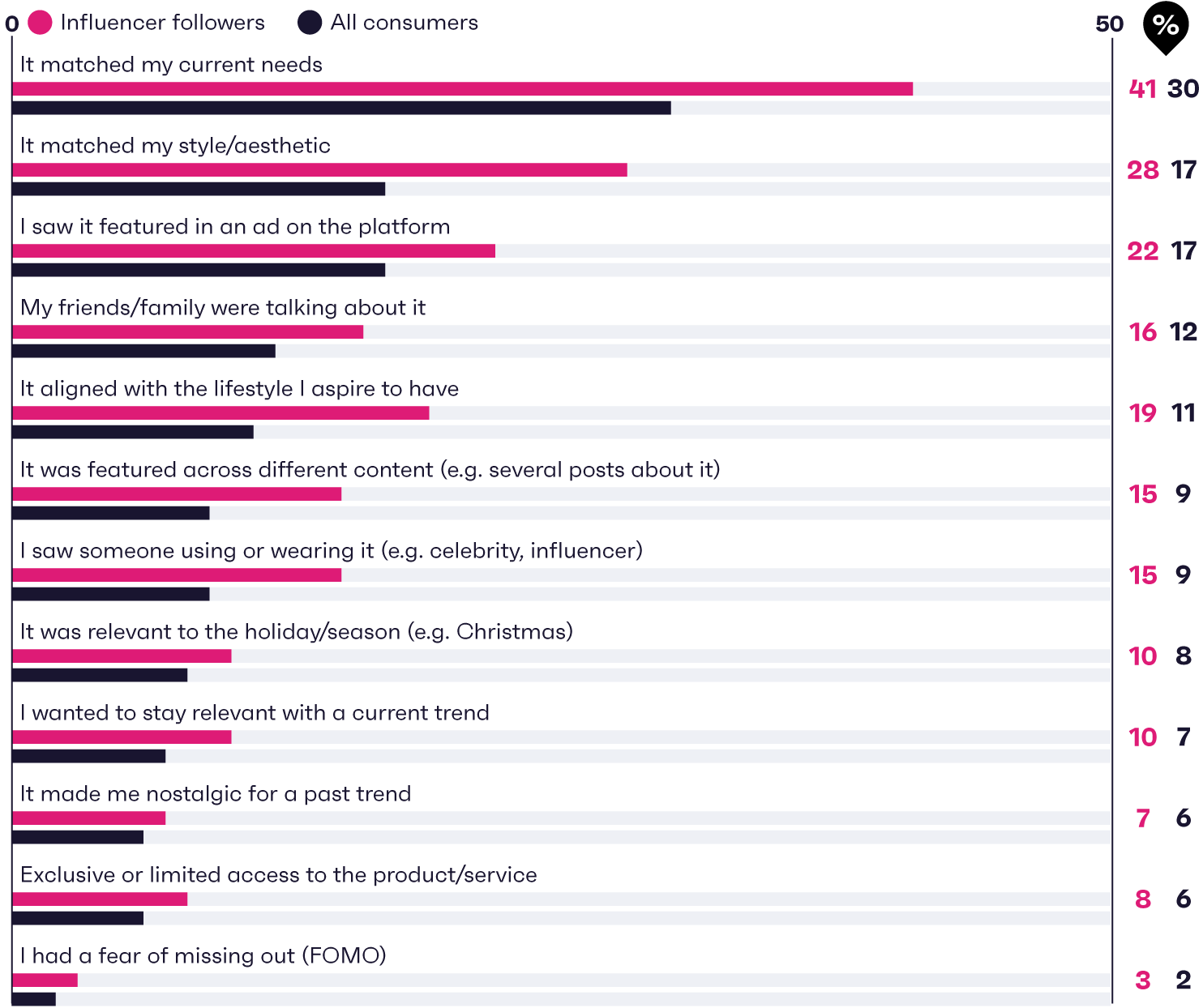
Influencer followers, just like all consumers, are motivated by their needs first and foremost. In fact, over 40% say it’s what matters most. Appealing to style and lifestyle aspiration may be more attractive to influencer followers than others, but brands often overlook the basics by trying to be trend-driven. Instead, messaging should focus on solving real problems or demonstrating how a product or service can improve their life right now.
This highlights the importance of brands understanding their audience, and the audience of their target influencer even more. This can save tons of money in the long run, boosting ROI for both parties.
And companies should remember: influencers know their audience best and want to feel like they’re part of the team, instead of being used for one-off projects or promotional posts.
Ask our customers
Consumers don’t just follow influencers for trends - they want solutions, connection, and belonging. The best brands understand moving beyond hype and co-creating with influencers is where they can truly connect culture and commerce. We believe participation is key, when brands involve both influencers and their audiences in the creative process, they don’t just create trust and stronger communities; they’re building their cultural resonance, deepening connections and driving real impact.

Influencer marketing is less about bringing promoters in at the last minute, and more about consistently working with ambassadors to create content and products they know their fanbase will love.

See the full picture with GWI Spark
Why stop at one audience? Your next consumer might not even be on your radar yet. GWI Spark gives you the lowdown on audiences yours interact with - to help you connect with fans you never knew you had.
Try GWI SparkMeet your audience on the platforms they’re on
The only thing left to consider is the platforms to concentrate your efforts on. There’s a slight disconnect between the apps companies use, and where consumers and business decision-makers spend their time.
Apps under-utilized by B2B and B2C marketers
Ranked order of apps used by companies, consumers, and decision-makers
- Source: GWI Work Q3 2024 & GWI Core Q3 2024
- Base: 31,430 business professionals, 145,540 internet users, and 13,516 business decision makers who say social media is influential aged 16-64 in 18 markets
Already a GWI user? Explore the data on the GWI platform
- Source: GWI Work Q3 2024 & GWI Core Q3 2024
- Base: 31,430 business professionals, 145,540 internet users, and 13,516 business decision makers who say social media is influential aged 16-64 in 18 markets
Already a GWI user? Explore the data on the GWI platform
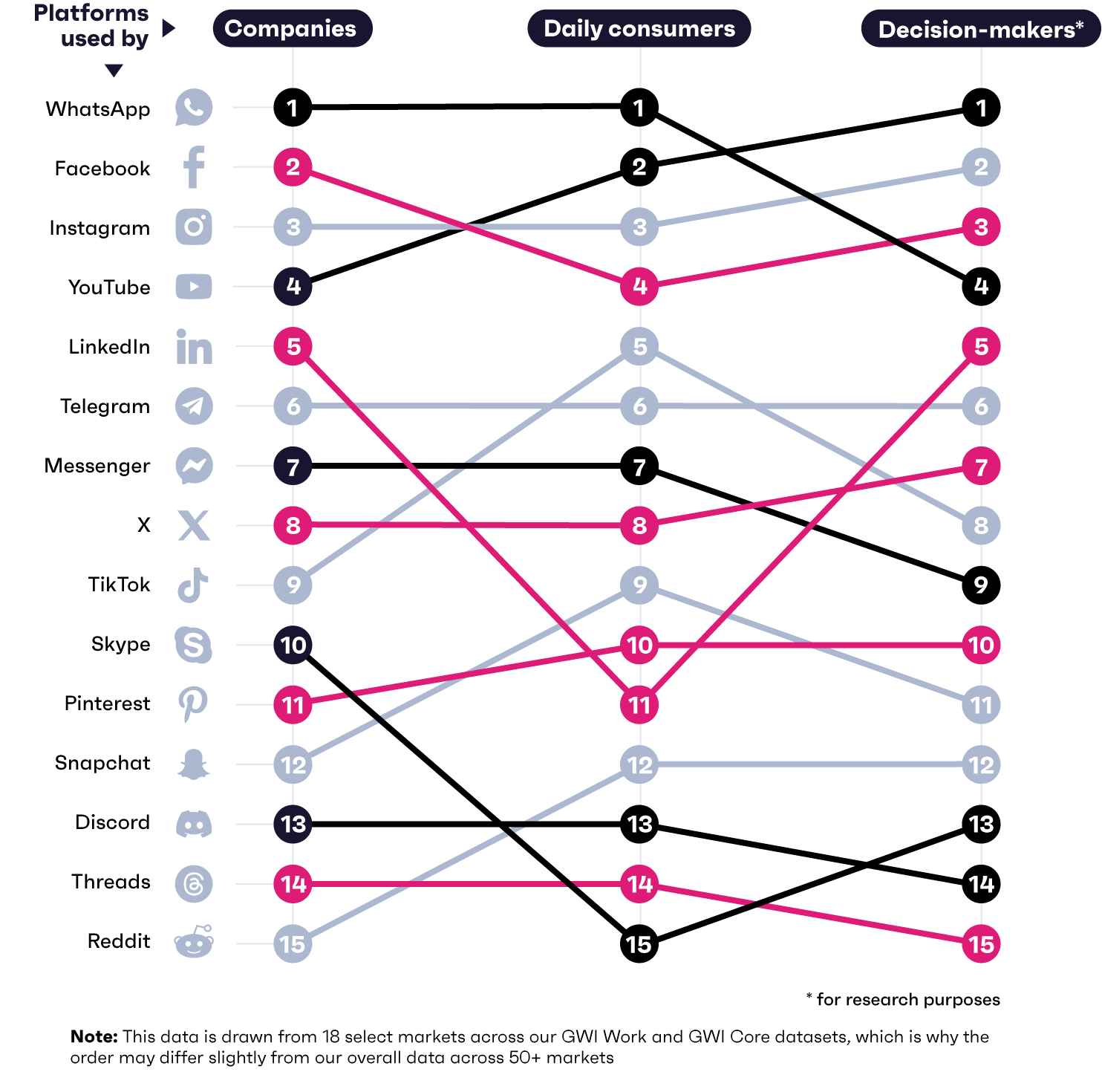
Building on that, more are scrolling with purchase intent in certain spaces. Instagram, Facebook, TikTok, and Pinterest have the highest share of users logging on to find product information, for example. Knowing that, brands should invest more effort into driving people to select in-app storefronts, where they can research and checkout in one stop.
Ask our customers
We're witnessing the rise of the next wave of shopping on social media. Consumers are able to explore new products, deep dive into specific options, and purchase what they need, all within a single visit. Platforms are finding new ways to encourage purchase and, for many, it's working. Whether it's live streams on TikTok featuring limited-time offers, exclusive product releases for your followers on IG, or easter egging product drops on Reddit, dimensionalizing the shopping experience goes a long way for consumers.
06
AI versus the
rulebook

When it comes to technology and regulation, so much has changed in a short space of time.
Social media’s largely gone unregulated until recently, and governments are finally catching up. Laws are being suggested left, right, and center, with more on the way. And AI’s been weighing on marketers’ minds since ChatGPT burst onto the scene in late 2022; they want to avoid getting left behind, while being careful not to rub audiences the wrong way.
It’s a lot to think about - we get it. But these actionable insights will hopefully help you get equipped for the days ahead.
Some AI-generated content has a headstart
Let’s start with AI. We asked marketing professionals how their companies have adopted it, and two of their top three use cases were content creation and customer service - both of which affect the social media side of their jobs.
And it’s important to keep track of consumers’ feelings towards all this. When it comes to companies using AI to make content, their reaction will partly depend on what it is. More people say they’d be interested in AI-generated music (60%) and comedy videos (57%) than ads (34%) or podcasts (35%).
Consumers aren’t so excited about ads in general because they know the end goal is selling to them, and they often get in the way when browsing. That doesn’t mean AI-generated marketing is a dead end though, just that companies may want to set up some focus groups before launching anything big and aim to use these tools in original ways. In 2022, Heinz asked Dall-E to create a picture of ketchup, which ended up looking a lot like its design. The final campaign joked that even machines think of the brand first. In this case, AI didn’t just generate a campaign, it inspired it.
Beyond that, AI-generated media is more welcome on certain platforms. Scrollers on apps like BeReal, Reddit, and X aren’t as ready for it, while Maybelline’s mascara CGI video stirred up a lot of interest on TikTok.
Some digital juries are closer to reaching a verdict
% of each platform's users who say they'd feel the following way if they discovered content they liked was made using AI tools
- Source: GWI Zeitgeist June 2024
- Base: 11,434 social media users in 11 markets aged 16-64
Already a GWI user? Explore the data on the GWI platform
- Source: GWI Zeitgeist June 2024
- Base: 11,434 social media users in 11 markets aged 16-64
Already a GWI user? Explore the data on the GWI platform
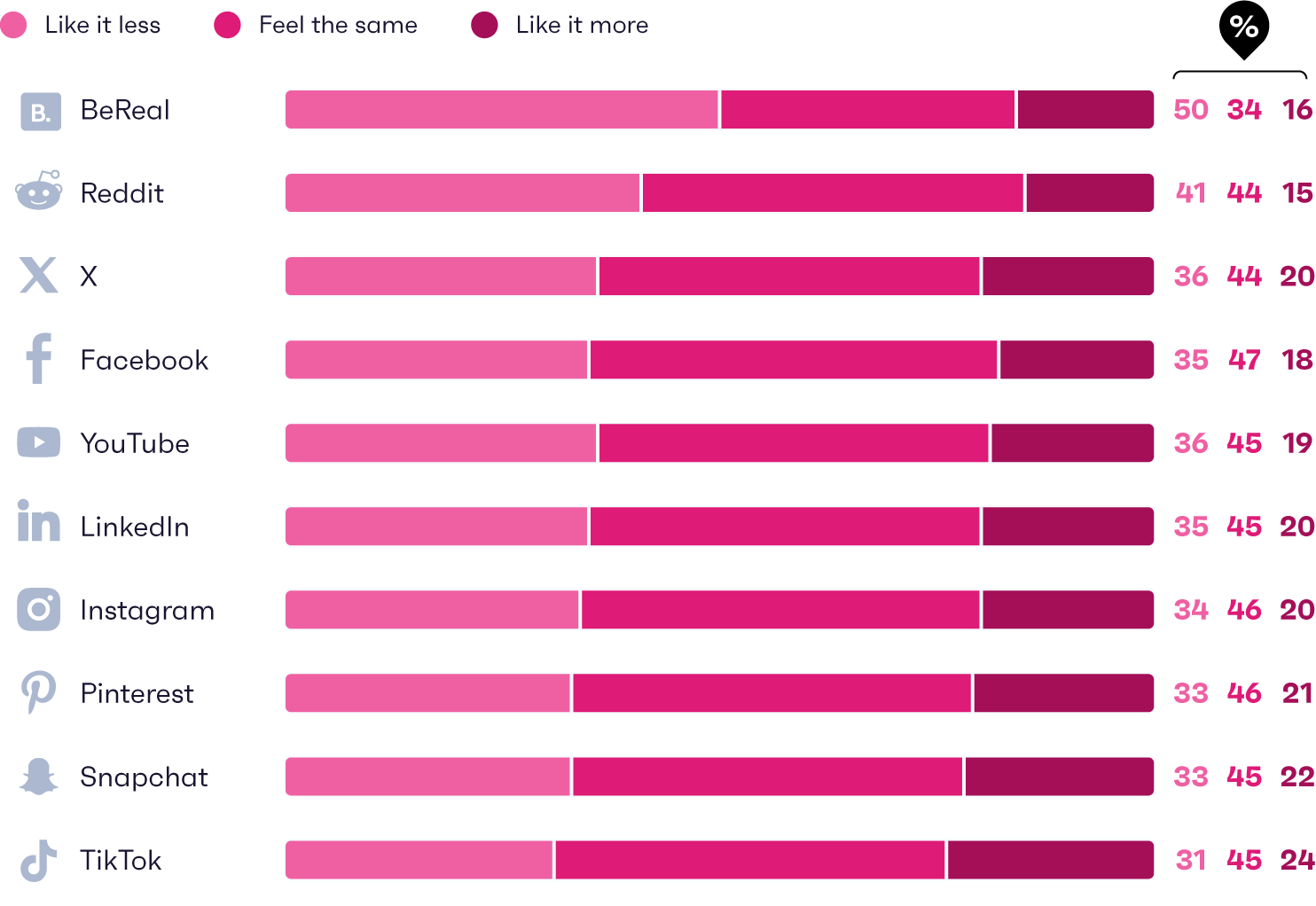
Regardless of where it ends up, this kind of content should be clearly labeled as such. Before paid partnership tags were introduced on platforms, people got annoyed when influencers didn’t openly admit that their content was an ad, and they won’t make an exception for AI-generated media. No one likes to feel lied to.

Back every move with GWI Spark
Why wait for insights when you can get them in seconds? GWI Spark gives you the answers you need to ignite your next big idea, so you can make smart decisions, maximize ROI, and stay ahead of the competition.
Try GWI SparkPlay a better customer service game with AI on the team
Chatbots are another popular AI use case for marketers, and people think they have their strengths. They can provide fast responses, are available 24/7, and stay neutral when faced with any issues. And there’s an opportunity for brands to use AI to get the conversation going with messaging app users.
AI chatbots should enhance customer service, not become it
% of AI tool users who say they feel the following way about interacting with AI chatbots vs humans
- Source: GWI Zeitgeist January 2025
- Base: 6,534 internet users who have used an AI tool in the last month aged 16-64 (16+ in select markets)
Already a GWI user? Explore the data on the GWI platform
- Source: GWI Zeitgeist January 2025
- Base: 6,534 internet users who have used an AI tool in the last month aged 16-64 (16+ in select markets)

Over 1 in 10 consumers interact with brands on messaging apps each month, and those who do are 1.5x more likely to use ChatGPT than average, and 1.9x more likely to send voice clips on social apps.
So, it makes sense that various brands use AI-powered chatbots on Facebook Messenger and are making moves in the AI audio space. Uber lets people order a cab simply by saying the words and other apps even give voice updates. We wouldn’t be surprised to see AI-generated brand voices replying to messages or comments in audio format sometime soon.
While AI chatbots can clearly enhance customer service by speeding it up, humans should still be on hand to follow up when people have complex queries, or aren’t satisfied with their answer.
Meeting tomorrow’s regulations today
Preparing for future bans is a bit trickier, especially as their effects aren't always immediate or universal. TikTok was banned in India years ago, yet a proportion of the nation still say they use it, presumably through VPNs. And Australia’s under 16s ban is set to take effect at the end of 2025, but there’s a lot of uncertainty around how it’ll be enforced, and debate over whether tweens’ usage can even be moderated.
That said, brands should have a gameplan and avoid putting all their eggs into one basket by building a strong presence across 2-3 video-based apps. Across 11 markets, Instagram and YouTube are the apps TikTokers say they’d rely on more if it got shut down in their country. There was a brief spike in RedNote, Xiaohongshu, and Triller downloads in the lead up to what ended up being a 12-hour US TikTok ban; but in the long run, the majority would likely turn to platforms that they or their friends already use.
Without social media, more time will likely be spent gaming
% of 12-15 year olds who think they spend the most time doing the following on weekends
- Source: GWI Kids Q1 2024
- Base: 11,160 internet users aged 12-15
Already a GWI user? Explore the data on the GWI platform
- Source: GWI Kids Q1 2024
- Base: 11,160 internet users aged 12-15
Already a GWI user? Explore the data on the GWI platform
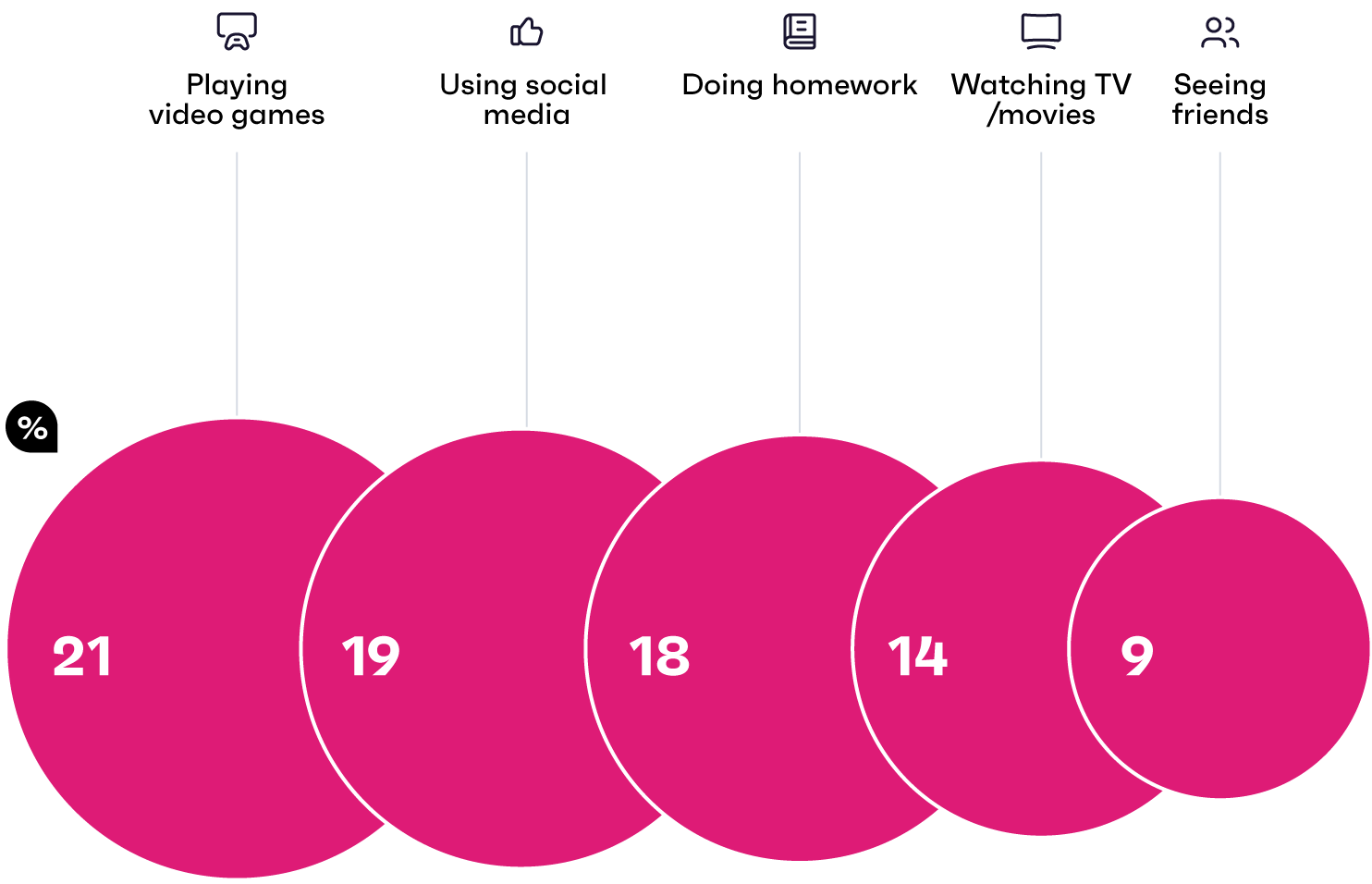
And in the case of teens, brands should think about where their social media time is likely to be redirected. Based on our data, we suspect a fair bit of it would shift to gaming. Given the line between gaming and social media is especially blurred for younger groups, companies can look to future-proof their brands by experimenting on their digital hang-outs like Roblox.
End of the feed
Social media doesn’t sit still, and neither should brands. They have to respond to AI, new platforms, and shifting behaviors in a carefully thought-out way.
Our advice? Show up where conversations are happening, make your content worth sharing, and turn insights into action. Brands that can show they really get consumers will have the edge it takes to stand out.
Notes on methodology
Each year, GWI interviews over 950,000 internet users aged 16-64 in 54 markets and 16+ in select markets (Canada, Hong Kong, Israel, Japan, Singapore, UK, USA) via an online questionnaire for our Core data set. A proportion of respondents complete a shorter version of this survey via mobile, hence the sample sizes presented in the charts throughout this report may differ as some will include all respondents and others will include only respondents who completed GWI’s Core survey via PC/laptop/tablet.
When reading this report, please note that we focus on data from our ongoing global quarterly research, but also refer to our monthly Zeitgeist studies across 11 markets, our GWI USA data set, which surveys over 80,000 internet users aged 16+ in the US annually, our GWI Work data set, which surveys over 31,000 business professionals in 19 markets aged 16-64 annually, and GWI Kids, which surveys over 21,000 internet users aged 8-15 each year.















